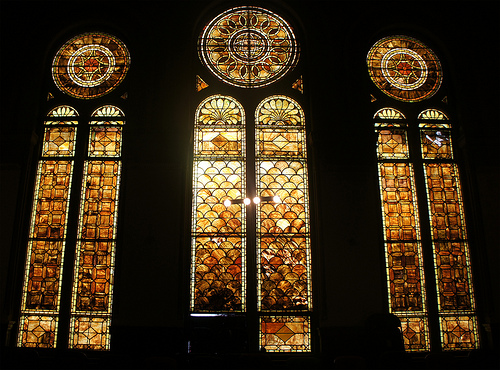
I. “Allow the Old Church to be Replaced With a New Building”
By Sheldon Fine
I have been an advocate for landmark preservation for decades. Locally, I have worked to preserve The Marseilles and the Euclid Hall, which are part of the West Side’s rich cultural and architectural history. I was also a strong advocate for the successful designation of the Manhattan Avenue Historic District.
But, in 2010, I did not support granting landmark status to West-Park Presbyterian Church (I submitted testimony to the city’s landmarks commission opposing the proposal), and I now urge the commission to remove that status and allow the old church to be replaced with a new building – one that would include space for both the church’s congregation and the cultural and community organizations that use the space.
Why allow the demise of an architectural fixture with a long history? First, I have always found the attempt to landmark religious institutions objectionable, on the grounds that it is an intrusion of the state into religion. Religious institutions exist first for their religious mission.
Secondly, the viability of the building’s structure is crucial for the safety of its congregants and others that use the space – as well as for those who pass by on the street (West-Park’s façade has been hidden behind a sidewalk shed for 20 years to ensure no crumbling pieces of the exterior fall on pedestrians). Only after these two concerns are met should the architectural and cultural significance of the building be considered.
When I opposed the landmarking of West-Park twelve years ago, I was familiar with the church from the activity of the West Side Ecumenical Ministry for the Elderly, which once had its home there. The Church was always strong in its mission and a leader in many movements advocating for social justice. But I was convinced that given the physical condition and the lack of funds available to make necessary repairs that granting landmark status would become a financial burden and restrict the church’s ability to continue effectively carrying out its mission.
My view did not prevail. Landmark status was granted, amid offers from community groups and individuals to help the church survive. But following landmarking, for the most part, the funding these groups and individuals promised did not materialize. Consequently, the building continued to deteriorate, and the unattractive sidewalk shed has had to remain up to protect passersby from harm.
Now, 12 years later, the façade remains a physical threat to pedestrians, the interior is is not a safe environment for congregants, and nothing has changed to improve the church’s ability to advance its mission within the community.
Facing an uncertain path forward after spending all of its resources to maintain the building, the West-Park Presbyterian Church’s leadership voted in 2020 to sell the property. The sale – which is contingent on removing the church’s landmark status so that it can be replaced with a new building — would provide the congregation with new resources. It would allow the church to thrive once again and secure a new space for worship. It could also provide new space for the arts programs and community activities that have used the church interior.
Questions have been raised about the church’s estimate that repairs and restoration of the building, as landmarked, would run into the tens of millions of dollars. Even if the cost is less than the church’s estimate, it is still well beyond the reach of the church. And those who advocated for landmark status 12 years ago did not come through with funds to make essential repairs. Meanwhile, the building has only deteriorated further, adding to the cost – and with no concrete plan in evidence for how to finance the repairs and restoration. If advocates of saving the building couldn’t come up with the money to do so 12 years ago, why would we think they will this time?
Some may argue that landmark preservation is such a vital public interest that it exceeds all other considerations. But it’s foolish to think that after all these years of neglect, the funds will ever be raised to repair, renovate, restore, and ensure the physical viability of the church. After the failed 12-year experiment with landmark status, it is time for the Landmarks Preservation Commission to approve the West-Park Presbyterian Church’s application, to remove its landmark status.
II. “A Way Forward for West-Park Presbyterian Church”
By David Westphal and Geneva Overholser
In 2004, the New York Landmarks Conservancy began surveying the city’s places of worship, trying to identify historically important churches, synagogues and mosques. A decade later, the conservancy had identified 1,200 religious buildings, and it pinpointed several that were believed to be particularly vulnerable to demolition.
Among them were Boerum Hill’s Church of the Redeemer, the Church of Our Lady of Vilnius in Tribeca and Washington Heights’ Wadsworth Avenue Baptist Church. The Landmarks Conservancy was prescient. Today all three are gone, victims of neglect and pressure from development interests.
They are part of a decades-old demolition story in New York of neglected churches and synagogues. Much of this is inevitable, and it quite possibly will accelerate as religious participation continues to decline in the United States.
But it needn’t always happen. And it shouldn’t happen at West-Park Presbyterian Church on the Upper West Side.
The church has proposed shedding its 2010 landmarks designation so that it can sell the 132-year-old building to Alchemy Properties, a development company, for $30 million. Alchemy would raze the church and build a 19-story luxury apartment at the site.
We believe this would be a terrible mistake. So does the Center at West Park, the nonprofit created in 2016 to manage the building as a performing arts center, as well as a continuing home for the Presbyterian congregation. More recently, the Lighthouse Chapel, a vibrant West African congregation, has worshiped there. We have been thrilled to attend some of the hundreds of music, dance and theater performances at the church, and look forward to the fall Evolution Festival, which will feature six works-in-progress by New York City artists.
The center’s work has not only made West-Park an important arts institution on the Upper West Side, but it has led the way in preserving this remarkable building.
When we bought our apartment 20 years ago, the presence of the Belnord across the street and of this church next door (not to mention Barney Greengrass in the building) was a huge part of the allure. Our AIA guide to the city calls West-Park “one of the West Side’s loveliest landmarks.”
It is an architectural treasure, one of only a few Romanesque Revival churches in the city. Its deep red sandstone glows in sunlight; we find it especially beautiful draped in new snow. It’s also a powerful connector to history, built at a time when the Upper West Side was just beginning to develop and steam locomotives plied the streets.
On Tuesday, July 19, the Landmarks Preservation Commission will continue its discussion of the church’s petition to de-landmark the building. The petition should be rejected. Why? Because there is a viable plan that would save the building from demolition and preserve it as a center for artistic, cultural and spiritual life on the Upper West Side.
The church argues that it can no longer maintain the building because necessary repairs would require a $50 million investment that its congregation, of just a handful of members, could not sustain. It further maintains that there is no realistic alternative that could lead to a real future for the building. As a result, the church says, the commission should de-landmark the building under a hardship provision, clearing the way for demolition.
It turns out, though, that there is an alternative. Engineers hired by the center concluded that the building is structurally sound and that the church has overstated the required renovation work. Further, supporters of the center have made a $3.5 million offer to buy the church, a proposal that would remove the central rationale of the church’s de-listing petition – that it can no longer maintain the landmarked building.
For the de-listing to succeed, the Landmarks Preservation Commission would have to conclude that there is little to no hope that the Center at West Park or anyone else could preserve the church. And that simply isn’t the case. The center’s six-year record of establishing a flourishing arts program, the $3.5 million purchase offer and the evident and robust community support for maintaining the church suggests that West-Park can have many good years ahead.
In 2020, Americans’ membership in houses of worship dropped below 50 percent for the first time.The resulting loss of members’ financial support has left religious institutions hurting for resources. For the New York City Presbytery, the $30 million offered by developers must seem an astonishing boon; surely many other denominations would feel the same. But if destroying the city’s architectural heritage becomes the new funding model for struggling religious institutions, just think what irretrievable losses our city will suffer.
Religious buildings such as this one grace streetscapes throughout the city. When one of them falls to the wrecking ball to be replaced (in this proposal) by another luxury housing building, a piece of the city’s heart goes with it.
Sometimes there is another way. If neighborhoods and city officials and religious organizations join forces, some of these churches and synagogues and mosques will be saved. New York would be a great laboratory for such collaboration.
West-Park opens that opportunity.










As soon as David Westphal and Geneva Overholser noted that they live next door to WPPC, their argument lost all credibility with me. Of course they don’t want construction next door, and of course they don’t want a building next door that will impact their views. I totally understand that.
What is not right is to act as though those are compelling reasons to keep a derelict building in place, while spinning tales of community cooperation and magical funding that will bring the church back to life.
As Sheldon Fine notes, there’s been more than a decade since the last round of this for the community to rally and get the repairs funded. That no one has done so is telling.
I agree, they clearly have a conflict of interest. It seems bizarre to me that people want to landmark this building against the church’s wishes. It’s unsafe and is a financial burden on the church, and they should be able to convert this lot to housing.
The “lot” won’t be converted to affordable housing! It will be converted to cold hard cash for the developer and those who run the Church.
The onus is on the property owner to maintain their building, not “the community.” Until now, there was never any great need for the community to rally to save the church. Apart from the issue of the sidewalk shed, the church is structurally sound and most of its façade in good condition, needing only minor repointing and dutchman repairs. It has continued to be used as a place of worship and arts center for the last decade. The costs to restore the facade have been artificially inflated– $25,000 to repaint a single window frame? I don’t think so.
It’s unfortunate the Presbytery never wanted to maintain the church but demolition by neglect is no excuse to grant their hardship application. The church is dwindling and now they’re looking to cash out.
They have already said they don’t have the money to restore it, hence the sale.
How much does annual maintenance on a 100 year old building in New York City cost? Can a 12 member congregation realistically raise enough donations to pay the ongoing cost of maintenance?
The church’s opponents imagine a world where an all volunteer religious board has chosen to spend decades in a “demolition by neglect” scam to… make a random developer rich? The church does not even have the money to pay a pastor anymore. They don’t have money to repair this building.
These accusations of “demolition by neglect” are offensive and don’t stand up to five seconds of thinking.
The church opposed landmarking from the outset. They are on record having wanted to develop the property for over 30 years. They have made no effort to maintain the building in a state of good repair, even using improper cement mortar in an effort to hasten facade deterioration. The former pastor physically defaced the stone inscription above the entrance in an attempt to prevent landmarking. It is indisputable that they are willfully practicing demolition by neglect to justify the de-landmarking of the property.
If the 12 member congregation cannot financially maintain the building they can sell it to a buyer willing to make those investments (they’ve received multiple offers), they are not entitled to a maximum return under the hardship provision under NYC Administration Code.
Of course they opposed landmarking from the beginning – the cost of maintaining the landmarked building has bankrupted the church. They can’t afford a pastor.
You can rant all you want, but the church’s opponents just can’t make the math add up.
“First, I have always found the attempt to landmark religious institutions objectionable, on the grounds that it is an intrusion of the state into religion”
Not exactly an impartial observer if you already believe houses of worship should never be landmarked!
This entire situation boils down to one, and only one, issue – finances. For the group that wants to keep the church, in the immortal words from the movie Jerry McGuire … “show me the money” … and this means not only to purchase the property, but to completely fix it up and MOST CRUCIALLY a sustainable financial plan to keep it maintained and operational so that we are not discussing this issue again in 10 years.
That’s it, plain and simple.
i think offering 3.5 million for that land is stealing. and manipulation. of public sentiment as a negotiating tactic is extortion.
if the community values the property that much pay for it or shut up. put your money where your mouth is.
The Church has enjoyed a tax free existence and now it wants its money. I say the community has already contributed enough.
Agree 100% – why should the church be forced to sell their property at 1/10th of the market value? The building is an eyesore, these neighbors just don’t want the construction.
I wonder if mr. Fine would be saying the same if this was not a church but a historical synagogue? I don’t think any religious building should be disqualified on that basis alone
This church was landmarked in 2010. Since then it has been a rotting hulk of a building surrounded by scaffolding, trash and homeless.
It is only now that someone who lives across the street from the church suddenly recognizes how “beautiful” it is and is fighting its demolition. He also claims a small not for profit organization is going to magically come up with $3.5M to restore the building.
It seems to me that nobody cared about this building until they realized its demolition and the new construction in its place will inconvenience them.
They don’t live across the street from it – they live in the Barney Greengrass building next to it, so they have an even more vested interest. Though I completely disagree with them, I do appreciate them at least being honest and upfront about that – they could have “conveniently” left out that piece of information.
If I am reading their argument correctly, someone has $3.5 million to buy the church. Perhaps the repair amounts are overstated, but I find it very hard to believe that it is structurally sound – a significant amount of repair work is definitely necessary. Who is paying for that? And who will pay the on-going costs of the building?
They have had 10+ years to figure this out. Give them to the end of the year to come up with a viable plan or it is done. The stall tactics are getting ridiculous.
I completely agree with Mr. Fine, and have been writing a very similar comment on several different sites. When he says, ” I have always found the attempt to landmark religious institutions objectionable, on the grounds that it is an intrusion of the state into religion. Religious institutions exist first for their religious mission,” he is stating what SHOULD be obvious: that the goals and desires of a congregation (of ANY religious institution) should come first, no matter what else is involved. And Mr. Fine is NOT adding something equally as important. It is not just “an intrusion” of the State into religion (and thus a violation of the congregation’s First Amendment right to the free practice of their faith), but also an illegal “taking” by the City. In fact, I spoke with two attorneys, one of whom specializes in landmarks law. They both told me that if the church sues LPC and the City, it will win. No question.
As for the other essay, the authors give their game away when they say, “When we bought our apartment 20 years ago, the presence of the Belnord across the street and of this church next door…was a huge part of the allure.” I have always suspected that, for many of the “Friends of…” (and with friends like them, who needs enemies?), this is about light, air and views. They also engage in some slick evasion when they say, “Alchemy would raze the church and build a 19-story luxury apartment at the site.” What they DON’T say is that the sale includes ample space for the church and its congregation. They also don’t given any information on the fact that the Center at West Park ALSO has options other than remaining in that building.
Ultimately, I go back to what I believe is the core fact: a “religious institution” is a building. Period. And the only people who should (and legally do) have a right to determine what happens to that building are its owners: in this case the church and its congregation. This should be axiomatic ethically and morally.
The arguments for preserving the church make no sense. One: it is unlikely that anywhere near the amount of money necessary can be raised. Two: the Arts Center that has been created will be preserved in the new, better, cleaner facility. Three: the argument that the city has lost many religious institutions only reflects the fact that the city has changed so that it no longer needs so many institutions. The Presbyterian Church, which supports demolition, has another facility in the area and realizes that this location is redundant.
3.5 million LOL And when the paperwork on that deal gets filed downtown and DOB does its required inspection to issue a new Cert of Occupancy, they will find the same unsafe conditions that will take 50 million to fix
Then what? The options are take it down and perhaps use some parts in the facade of the new building, or keep it landmarked and wait for it to fall in a bit more until DOB declares it hazardous and orders it demolished
Great point, and then what? The arts group that takes possession of the property at a knock down price gets the windfall profit at the expense of the church which was strong armed into surrendering its real estate, Let’s be real if not subject to LPC regs, the fair market value of that lot is well into the tens of millions. That money would go a long way to supporting the church’s long and admirable charitable mission in this neighborhood.
West Park was only landmarked because a Gale Brewer and others got at LPC to save what was then a hulking wreck of place going to rot and ruin.
Ms. Brewer et al promised at the time ample funding would be found to repair and restore WP, this despite the woman knowing full well no taxpayer money could ever be used for those purposes.
It has been over a decade, and clearly no one is going to “save” West Park, time to let it go….
If residents of co-op buildings on either side of WP want to preserve their lot line views, pony up money to make a decent offer for the property. Am not talking about some low ball charity amount, but what lot is actually worth, which is quite a lot actually.
Nothing lasts forever. Tear it down.
It’s not a landmark at this point, it’s clearly a land stain. Replace it with a soaring condo tower or a vacant lot, anything would be better…
Get. Rid. of. It!!!!
That is not the question. Who is going to pay to have it preserved? If the city votes to preserve it, then they must also come up with the money to do it.
That is a large part of the problem. The city does not have to contribute to a landmarked building’s maintenance and repair, but the Owner is saddled with getting any exterior repairs approved by LPC and then the repairs have to be done in kind. For example, if there is a terra cotta ornamentation that is crumbling it has to be replaced with terra cotta, not some modern material such as a lighter and easier to install fiberglass recreation (which would be indistinguishable from street level); of course before you even get to that point, your architect/engineer has to submit plans for approval and you have to wait for LPC to consider answer all its questions, and finally approve.
A recent poster on this topic saliently noted this should impact the takings clause of the Constitution, a government is restricting what you can do with your property without offering to pay you for it. For what it is worth, I was recently in Vancouver and discovered when that city designates a “Heritage Building” the city sends the owner money to help offset the extra cost of the maintenance. NYC does no such thing.
Can someone provide an update on what Gale Brewer said in her press conference yesterday?
Thanks.
It is tragic that such a rich city can’t find the means to preserve this magnificent landmark. Surely one of our billionaires could shake loose a little change to preserve such a fine building. If it is no longer viable as a church, then, certainly, it could serve many other purposes, as well as providing visible substance and character to the community.
One day UWs residents are grumbling and moaning about “billionaires”, next they want same to cheerfully donate vast sums to their pet causes. Make up your minds…
Wealthy are same as anyone else, they do not donate their resources nor money in aid of causes fueled by those who otherwise have no use for themselves.
I don’t live near this church. I’m 10 blocks away.
Please Please tear it down remove the landmark status. It’s an unusable community building!
I used to go to all types of community meetings in this church community center. they’re no longer held there because it’s a deteriorating building.
It’s a fantasy that anyone has the money or can raise the money to bring it up to any standards to use this building again. It serves very few in the community.
https://absaloncph.dk/en/about-absalon/ It would be amazing if a developer could follow Absalon’s lead and convert it into a community center with events, games, and inexpensive communal meals. I loved hanging out and meeting people here when I studied in Copenhagen a few years ago.